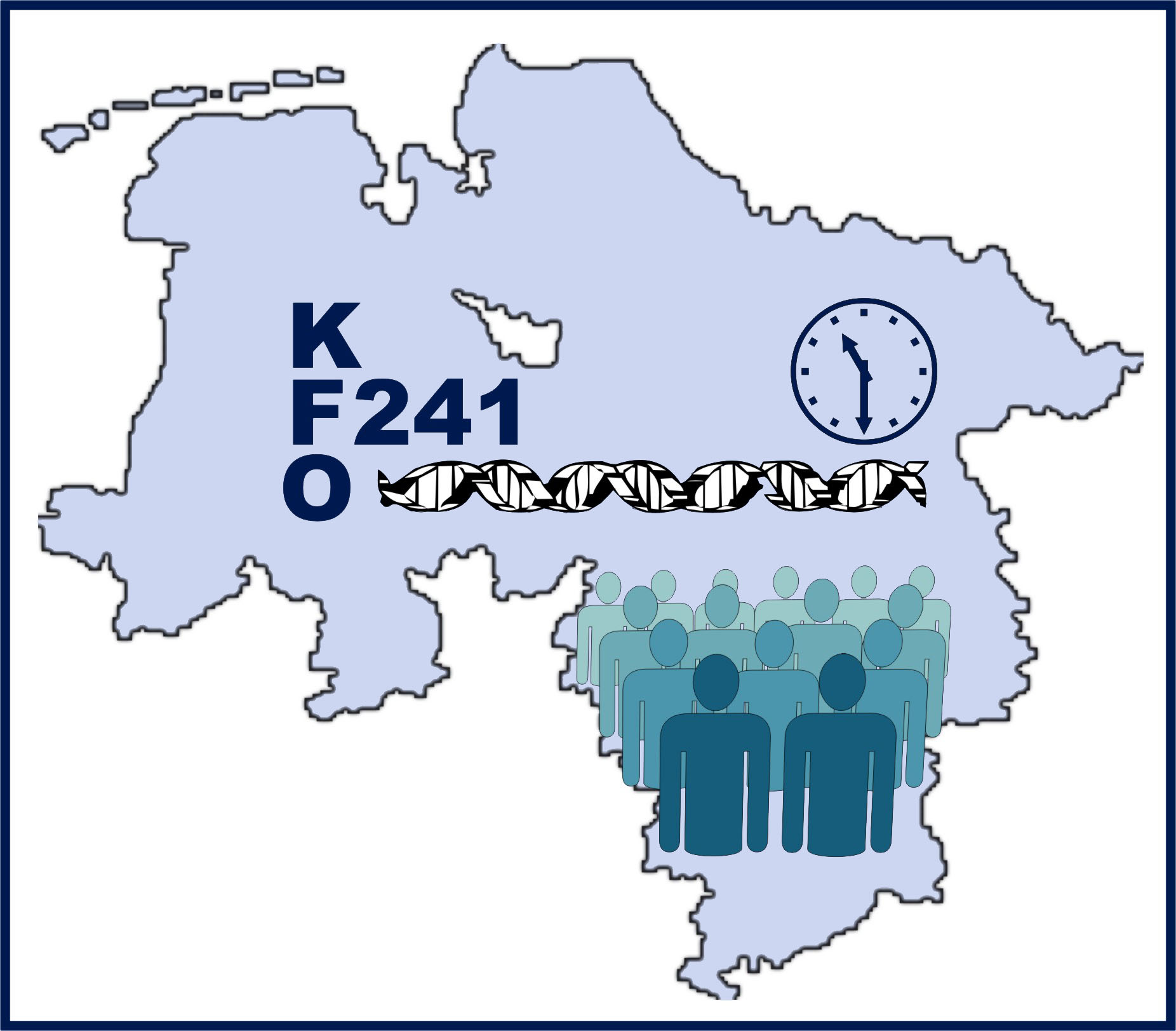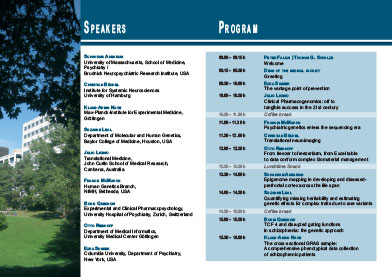|
9.00 - 9.15
|
Welcome
Peter Falkai | Thomas G. Schulze
|
|
9.15 - 9.30
|
Greeting
Research Dean of the Medical Faculty
|
|
9.30 - 10.00
|
The vantage point of prevention
Abstract
Abstract
This talk will discuss novel findings that suggest potential for prevention of schizophrenia.
It will focus primarily, though not exclusively, on the use of micronutrient supplements during pregnancy to
prevent schizophrenia in offspring. Nutritional supplements are already used to prevent neurodevelopmental
disorders such as cretinism and neural tube defects. Recent results suggest that they may also reduce the
risk for others, such as severe language delay and autism. Schizophrenia poses a greater challenge, because
the long delay between birth and onset of a psychotic syndrome poses a barrier to the strong observational
studies and randomized trials required to test preventive interventions. I will propose ways in which this
challenge could be met.
Ezra Susser
Chair: Thomas G. Schulze
|
|
10.00 - 10.30
|
Pharmacogenomics: off to tangible success in the 21st century
Abstract
Abstract
The initial sequencing of the human genome in 2000 was met with enormous enthusiasm about practical
application in medicine. Top amongst those was the hope that genetic markers could predict treatment outcomes.
Up to the present time most treatments consist of an n=1 study. Some people will improve, others will not benefit
much or at all, while some will have no adverse outcomes, and yet others will suffer from varying degrees of adverse
drug reactions. I would make the case that the current practice of medicine is archaic and needs drastic updating.
Pharmacogenomics offers the hope of if not actually personalizing treatment, at least stratifying it in a much more
contemporary, evidence-based manner. Because the initial promise stemming from the sequencing of the human genome
is now 12 years old, there has been some loss of enthusiasm. We believe that this is unwarranted. Rapid and
inexpensive genotyping and sequencing of vast cohorts are very likely to provide the data needed for pharmacogenomics
to become a clinical reality in the 21st century.
Julio Licinio
Chair: Jürgen Brockmöller
|
|
10.30 - 11.00
|
Coffee Break
|
|
11.00 - 11.30
|
Psychiatric genetics enters the sequencing era
Abstract
Abstract
Next-generation technologies have enabled the rapid sequencing of human genome at a pace and scale
that was impossible just a few years ago. The technologies have already been used to detect Mendelian disease genes
in the coding regions of the human genome, and are now being used in complex disorders as well. How will psychiatric
genetics use these technologies in the coming years? Will genome sequencing finally reveal major alleles that cause
psychiatric disorders, helping to close the heritability gap left behind by genome-wide association studies?
Can techniques such as RNA-seq reveal differences in expression, splicing, and RNA editing that play an important
role in psychiatric disease risk? How can we use nucleotide-level information from individual patients to refine
diagnoses, plan treatments, and improve outcomes? Progress toward answering these questions will be presented,
along with a discussion of the major challenges facing the field as we enter the Sequencing Era in psychiatric genetics.
Francis McMahon
Chair: Thomas G. Schulze
|
|
11.30 - 12.00
|
Translational neuroimaging
Prof. Christian Büchel
Chair: Oliver Gruber
|
|
12.00 - 12.30
|
From freezer to freezerfarm, from Excel table to data conform complex biomaterial management
Otto Rienhoff
Chair: Thomas G. Schulze
|
|
12.30 - 13.30
|
Lunch
|
|
13.30 - 14.00
|
Epigenome mapping in developing and diseased prefrontal cortex across the life span
Abstract
Abstract
Neurons residing in the human cerebral cortex permanently exit from the cell cycle during the second trimester
of prenatal development, but little is known about changes in neuronal chromatin during the subsequent periods of
maturation and aging, or potential alterations in neuropsychiatric disease. Here, we explore the genome-wide
distribution of histone H3-trimethyl-lysine 4 (H3K4me3), an epigenetic mark associated with transcriptional regulation,
in neuronal chromatin from the prefrontal cortex across the lifespan, and in a cohort of subjects diagnosed with autism
and other neurodevelopmental disease.
We present evidence for a highly regulated, 'pre-programmed' remodeling of histone methylation landscapes in immature
prefrontal cortex neurons that continues at least into the early childhood years, involving hundreds of loci and a distinct
set of transcription factors. Changes during subsequent decades of life were comparatively minor.
Furthermore, histone methylation alterations in prefrontal neurons of 16 diseased subjects (autism) were highly variable.
As a group, loci with disease-associated H3K4me3 alterations showed a significant, 2-3 fold enrichment for genes implicated
in cognition and social behaviors and heritable risk for neurodevelopmental disease. We estimate that less than 3% of
altogether 711 loci affected in our cohort of 16 autism subjects were related to a copy number variant in cis. Taken together,
these findings highlight the 'epigenetic vulnerability' of the immature prefrontal cortex and point to significant overlap
between the genetic and epigenetic risk architecture of autism spectrum disorders.
Schahram Akbarian
Chair: André Fischer
|
|
14.00 - 14.30
|
The cross-sectional GRAS sample: A comprehensive phenotypical data collection of schizophrenic patients
Abstract
Abstract
Over the past 7 years, we have set up a comprehensive phenotypical database of schizophrenic patients, the GRAS
(Göttingen Research Association for Schizophrenia) data collection. Between 2005 and 2008, a research team of the Max Planck
Institute of Experimental Medicine, consisting of a neurologist/psychiatrist, 2 psychologists, and 3 MD/PhD students, visited
23 clinical centers throughout Germany, and examined over 1200 patients with schizophrenia. This investigation included, in
addition to cross sectional data acquisition, a meticulous evaluation of chart records and discharge letters to consolidate
and confirm patient data in a most detailed and reliable fashion. This project has led to the world-wide largest currently
available phenotypical data set of schizophrenic patients (>3000 data points per subject), obtained under highly standardized
conditions by one and the same clinical research team. Steady-state recruitment is ongoing.
With this database, we have already been able to deliver proof-of-concept for our approach to understand the
contribution of 'normal genotypes' to the (schizophrenic) phenotype. Examples will be presented. Among others, this approach,
which we termed phenotype-based genetic association studies (PGAS), can (1) distinguish biological subgroups of schizophrenia,
(2) unmask genetic and environmental modifiers of the disease course, (3) help to understand the role of selected genes in normal
human development and brain function, (4) provide the basis for more detailed mechanistic studies involving genetic mouse models,
and (5) help to select specific patients for detailed follow-ups and in-depth investigations.
In spring 2012, we will have the results of a custom-designed SNP chip array available, comprising more than
600,000 SNPs, including e.g. more than 20,000 markers in the extended MHC region. This array will be used for genome-wide genotyping
of the GRAS sample and of more than 1200 healthy controls. A detailed serological profile of all patients and controls is currently
being generated, including information on past and present, acute and chronic infections with more than 30 neurotrophic viruses.
Klaus-Armin Nave
Chair: Peter Falkai
|
|
14.30 - 15.00
|
Coffee Break
|
|
15.00 - 15.30
|
TCF 4 and disrupted gating functions in schizophrenia
Abstract
Abstract
Several polymorphisms of the transcription factor 4 (TCF4) have been shown to increase the risk
for schizophrenia, particularly TCF4 rs9960767. However, the impact of common variants on schizophrenia risk is
rather small and single polymorphisms, as such from the TCF4 gene, were not shown to have any predictive value
so far. Thus, we employed the endophenotype approach to investigate whether TCF4 polymorphisms contribute to
disrupted gating functions consistently displayed by subgroups of schizophrenia patients. In a series of studies
with healthy controls and schizophrenia patients we examined if sensorimotor gating and auditory sensory gating
are associated with TCF4 polymorphisms. Sensorimotor gating assessed by prepulse inhibition (PPI) of the acoustic
startle response and auditory sensory gating measured by P50 suppression of the auditory evoked potential are both
established endophenotypes of schizophrenia. Although both measures are procedurally similar they are usually not
correlated and might be regulated by different but overlapping neuronal pathways. Across three studies, both
sensorimotor and sensory gating was strongly associated with TCF4 polymorphisms. Interestingly, the impact of
several TCF4 polymorphisms on sensory gating was dose-dependently modulated by smoking. In conclusion, our results
suggest that common TCF4 variants might play an important role in the development of diminished gating functions
in schizophrenia. Furthermore, an extended endophenotype including gating functions, smoking behavior, and TCF4
genotype status warrants testing as an early indicator for a developing psychosis.
Boris Quednow
Chair: Moritz Rossner
|
|
15.30 - 16.00
|
Quantifying missing heritability and estimating genetic effects for complex traits due to rare variants
Abstract
Abstract
Complex trait rare variant association studies using sequence data are being widely performed.
Analyzing rare variants individually is extremely underpowered; therefore many powerful rare variant
association methods have been developed, which are based upon jointly analyzing multiple variants within
a region which is usually a gene. After an association is identified, it is also important to estimate
genetic parameters of interest and quantify the proportion of heritability explained by the gene.
A drawback of rare variant association methods is that it is not possible to tease apart causal
from non-causal variants. Consequently, the causative-variant-effect is not estimable. We describe how to
efficiently estimate the genetic-average-effect. Due to the presence of non-causal variants, genetic
variance explained by the genetic-average-effect will be underestimated but provides a lower bound for
the true underlying locus genetic variance. An additional problem is due to the winner's cure the naïve
estimator can be seriously inflated. The bias is quantified and it is shown that even for poorly powered
studies a boot-sample-split procedure can be used to greatly reduce the bias of the genetic estimates.
Not only are these methods vital for estimating the amount of missing heritability due to rare variants,
but they are also important for designing replication studies and risk prediction.
Suzanne Leal
Chair: Heike Bickeböller
|


